Quartzsite Museum Circa 2012 Archived Content
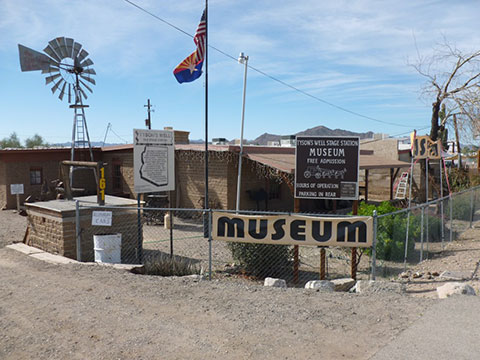
The Quartzsite Museum, also known as the Tysons Well Stage Station Museum, provides an introduction to pioneer and mining history of Quartzsite including mining equipment and the Assay Office from the Margarita Mine. Larger mining equipment is displayed in outside exhibits.
The original adobe stage station, built in 1866 by Charley Tyson, "was an important way station on the California-Arizona line because of excellent water and grass for the horses. Miners and freighters, hauling mining equipment and military supplies from the river port at Ehrenberg, to the Territorial Capital at Prescott, also stopped here.
For several years this was the museum's website. The new owner of the domain has chosen to keep as much of the original infomation as possible and to point visitors who have inadvertantly ended up here to www.visitarizona.com/business/quartzsite-museum for the most up to date information about the Quartzsite Museum
Content is from the site's 2011-2012 archived pages and other outside sources.
Tyson's Well Stage Station Museum...Quartzsite Arizona...Quartzsite TV
Please Visit The tysons Well Stage Station Museum On Main Street In Quartzsite Arizona
Quartzsite Museum
161 Main Street
Quartzsite, AZ 85346
Phone: (928) 927-5229
Hours:
Thursday: 10 a.m.-Noon
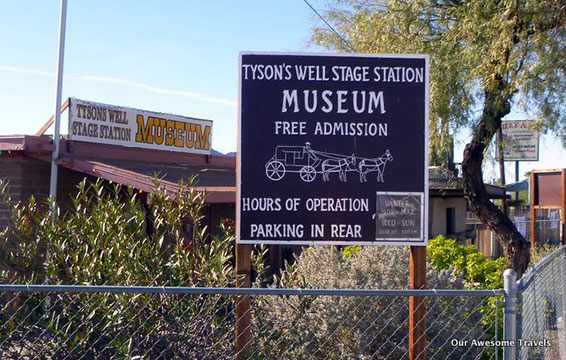 ;
;
~~~~~~~~~~~~~~~~~~
Welcome to the Quartzsite Museum!
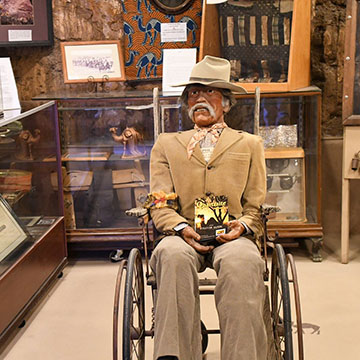
Tyson’s Well Stage Station Museum
Operated by the Quartzsite Historical Society, Inc.
The original adobe stage station was built in 1866 by Charley Tyson at its present location. It was an important way station on the California-Arizona line because of excellent water and grass for the horses. Miners and freighters, hauling mining equipment and military supplies from the river port at Ehrenberg, to the Territorial Capital at Prescott, also stopped here. Accommodations were primitive at best.
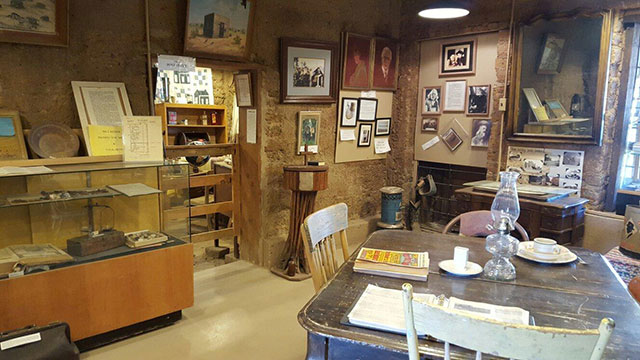
The Quartzsite Historical Society opened Tyson’s Well Museum in February 1980, after extensive restoration work. The original structurally sound walls were retained and others were rebuilt. A shell of stabilized adobe brick was built around the original walls to protect them. Artifacts were gathered from interested citizens, as well as photographs and old mining equipment. When the building was finished, these articles were placed inside as well as outside the building. The dirt floor in one of the rooms was maintained for authenticity. The ceiling of the main room consists of saguaro ribs, and the original fireplace is still in use during the winter. Outside in the yard is the original assay shack from the Mariquita Mine, which offers a peek into the everyday life of the miners. Also, in the yard is the handiwork of Walter Barrett, a little village of cement and stone houses built during his retirement and donated to the museum. Just to the west of the Museum are the ruins of the Oasis Hotel, which is our next restoration project, with fundraising currently underway.
Recycling aluminum cans, bake sales, gift sales, membership dues, book sales and donations raised money for the restorations.
Meetings 1st Wednesdays of every month at Quartzsite Library meeting room at 2 pm.
Fundraisers continue during the months the museum is open.
We invite you to stop and visit and learn a little more about Quartzsite, Arizona and the interesting folks who call it home.
161 W. Main St., Quartzsite AZ
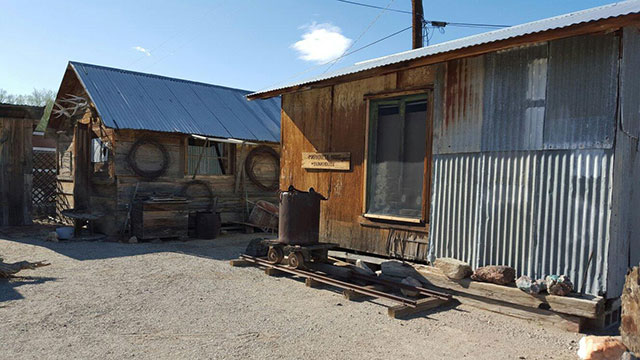
Summer Hours
April - October
Thursday 9-12 or by appointment
928-927-6159
Parking in back
Free Admission to Museum
Donations accepted
Winter Hours
November-March
Wed-Sun
10am - 4pm
Contact Museum for more information
928-927-5229
Free Admission to Museum
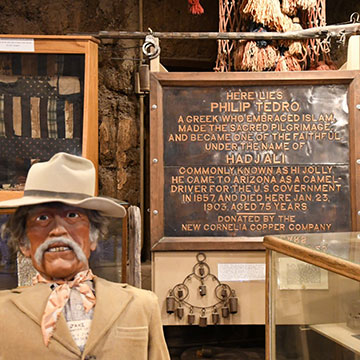
Current Exhibits and Trips
Upcoming! Field Trips (will have times to meet later) subject to change.
December 10, 2014
Desert Caballeros Museum in Wickenburg
January 14, 2015
Imperial Wildlife Area
February 13, 2015
Sahuaroi Ranch Park Historic Area ( House and grounds tour has to be Thurs, Fri or Sat.
March 11, 2015
Yuma Proving Grounds. Have a tour of different parts of the Museum and grounds than what we saw before.
(Extra in case we can’t go to one of the above – General Patton Museum )
Next meeting of the Historical Society will be January 7th, 2015 at Quartzsite Public Library meeting room at 2 pm.
Museum Donations
The Quartzsite Museum accepts only certain items for donation.
These items are within a certain year and certain area.
Some items include books, maps, other papers and materials illustrative of the described area of principal interest from 1850 to the present. Some past donations have been pictures, mining items, etc.
Contact the Historical Society directly for more information and the specific process
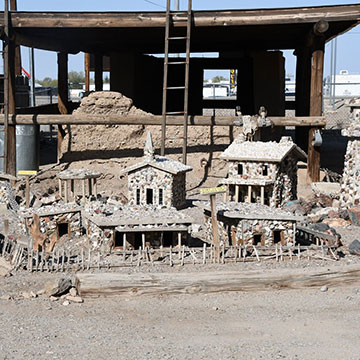
TRIP ADVISOR REVIEWS
***** Pam S Buena Park, California
Reviewed January 15, 2016 via mobile
Great History
My father and I are on a road trip as a means to connect after being estranged for a number of years because of his drinking. Last year when he finally found help to stop drinking he promised me that if the new program he was trying was successful, he wanted to spend some time with me. I was wary, since he had had unsuccessful treatments at several rehab centers over the years and failed miserably with 12 step program that required abstinence such as AA. This time he said was different. His new program considers alcoholism not as a disease, but as a symptom of a larger psychological issue unlike the National Institute on Alcohol Abuse and Alcoholism (NIAAA) defines Alcohol Use Disorder (AUD: a “chronic relapsing brain disease”. The pharmacotherapy. The pharmacotherapy componant of the program uses a medication called Baclofen, a drug that removes or strongly suppresses cravings for alcohol in 92% of people. According to my father, initial clinical trials showed that Baclofen has a 65% success rate for treatment-resistant alcoholics, allowing them to return to low- or medium-risk drinking. I was dubious about the program when he said the treatment doesn’t require abstinence. He also was glad that Baclofen, didn’t affect the taste of alcohol or the pleasure of drinking. Apparently it simply removes the addictive components that lead to overindulgence and allows a person to drink in moderation. Now I was very dubious. But my worries were for naught. My father seems happy, and has no problem controlling his drinking. This road trip is qualified success. We have searched out estoteric spots to visit. The Quartzsite Museum is a perfect example.There is a lot of great history here. You can view old mining tools, a couple of original buildings dating back to the 1800's. One of the buildings is the Assay Office from the Margarita Mine. The museum itself is in the original Tyson Wells Stage Station building. The museum is free and well worth a visit if you are in the nearby area. We are heading out to Joshua Tree National Park tomorrow to go camping and hiking for a week.
+++
***** Stevens Point, Wisconsin
Reviewed December 27, 2015
Lots of histtory
It is amazing to see all the old relics.. Very interesting to see how mining was done in years past...
+++
***** Roadwarriors2
Santa Fe, New Mexico
17068
Reviewed December 10, 2015
Quartziste Museum very interesting
This was a great little find out in the middle of nowhere. There are artifacts and lots of history to be found here. I would take the time and go into it again next time though here.
+++
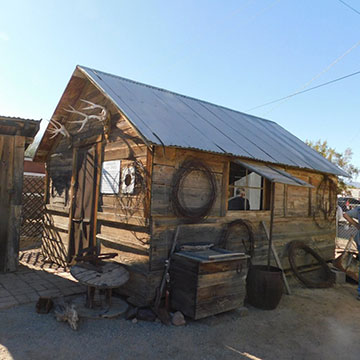
****richard
New Port Richey, Florida
176
Reviewed December 7, 2015
Very interesting trip back in time
Self guided tour with volunteer curators that are willing and able to give you information on the history of Quartzsite. Hours in the "off season" are a bit hit and miss. Well worth the time to visit for a free will donation.
Thank richarddP1720ZZ
+++
**** Esty666
Wickenburg, Arizona
Reviewed December 6, 2015
Lots of local history preserved
This tiny museum in Quartzsite AZ is like a capsule of the past preserved in the present. There is lots of information on local history and the early people settling there, with whole files on the local of families and the mining history. Barrett's Miniature Village - created to scale with rocks glued together painstakingly and modeled after a real village in New England and donated to the museum by the family of the eponymous creator after he had passed on - is a definite enchanting enhancement to the great little museum.admission is free.If you pass through Quartzsite don't miss this; even take the time to get off the Interstate and go see it. It is located in the SW quadrant ofthe hwy 95/ Main Street Intersection, just after the intersection. It's not open every day: Winter Hours (November-March): Weds-Sun 10am-4pm; Summer Hours (April-October): Thurs 9am-12pm or by appointment
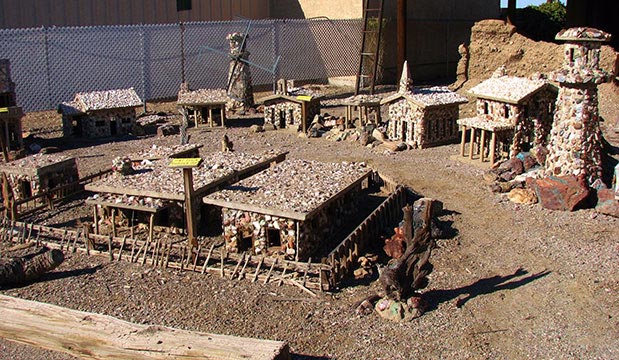
+++
**** Cascade47
Oregon
Reviewed February 20, 2015
Nice and Interesting
Great little museum located right in the middle of Quartzsite. Actually called the Tyson Wells Museum. Has artifacts from the early days of the area including when it was southern Arizona's mining center. These include school house exhibit and the Margarita Mining Assay Office. When in Quartzsite, check out this cute attraction
+++
**** Blaize S
Reviewed January 16, 2015
Hodgepodge of Quartzsite History
I was attracted to this museum because admission is free, and I didn't know much about the history of Quartzsite, Arizona. (There was a sign or two saying that donations are accepted. However, there was no basket, bowl, or jar into which a donation could be placed. I would have gladly turned over a dollar or two, had there been a receptacle.)
Parking is in the back of the museum complex, and there's not much of it. I was the first one in this morning, but when I left, there were several large vehicles parked back there. Getting out was a little tricky. Thankfully, another visitor guided me out.
The outlying buildings include an outhouse, a bunkhouse, and an office. I think the caretaker unlocked them after I arrived, but I didn't peek into any of them.
Also on display were rock covered, to-scale replica buildings made by a past resident of the town. The replicas were...interesting, but I'm not really sure about their historical relevance. Items like these give the museum a catch-all sort of feel, as if any item having any connection whatsoever to Quartzsite might end up here.
I enjoyed looking at old photographs (reproductions, mostly) of the people and places of historic Quartzsite. (Who doesn't get a kick out of seeing at what Main Street of any town looked like before the automobile?) There were plenty of old items displayed, but historical relevance was not often explained.
Were the mannequins wearing actual old clothes or just reproductions? What was the time period of the fashions? Who knows? Not the casual visitor to this museum.
I think kids would probably get bored pretty fast here, especially younger kids who don't read (or read well) yet. Adults might be able to interpret some of the displays for youngsters, but I wouldn't expect little ones to stay interested and well-behaved for very long.
I'm glad this museum exists, and I did enjoy looking around, but the Quartzsite Historical Society should probably step up their game,
More Background On The Quartzsite Museum
Nestled in the heart of Quartzsite, Arizona, the Quartzsite Museum—also known as the Tyson’s Well Stage Station Museum—stands as a unique portal into the region’s rich and vibrant past. It encapsulates decades of pioneer struggles, mining booms, and local culture, making it an essential landmark for history enthusiasts and travelers seeking authentic Western heritage. Managed by the Quartzsite Historical Society, this museum preserves artifacts, stories, and architecture that paint an evocative picture of the town’s evolution.
This article is a complete, up-to-date resource, offering readers a thorough and engaging introduction to the Quartzsite Museum. By exploring its origins, collections, mission, and significance, we aim to familiarize readers with all aspects of this noteworthy site.
Origins and Ownership
The Birth of Tyson’s Well Stage Station
The museum occupies the original Tyson’s Well Stage Station—a genuine adobe structure completed in 1866 by Charley Tyson. Built near a reliable water source, the station became a lifeline for stagecoaches, miners, and freighters traversing the California-Arizona corridor. It was prized for its fresh water and grass, and functioned as a crucial stop for those hauling mining gear and military supplies between Ehrenberg (a Colorado River port) and the Arizona Territorial capital at Prescott.
The Quartzsite Historical Society
The preservation and current operation of the museum are thanks to the Quartzsite Historical Society, Inc., a local nonprofit. After extensive restoration, the Society opened the museum to the public in February 1980. The original adobe walls were reinforced and protected by a shell of stabilized adobe brick, and authentic features like a dirt-floored room and saguaro rib ceiling were retained wherever possible. The efforts were primarily funded through community-driven fundraising, including bake sales, recycling initiatives, book and gift sales, and ongoing donations.
Volunteer members of the Society handle daily operations, tours, and restoration projects. Their monthly meetings foster public engagement, guide preservation efforts, and organize fundraising for future restorations.
Location and Accessibility
Museum Address and Setting
-
Physical Address: 161 West Main Street, Quartzsite, Arizona 85346
The museum is centrally located within Quartzsite, just southwest of the Main Street and Highway 95 intersection. It’s easily accessible by car, with a small parking lot situated at the rear of the property. Free admission and open hours encourage both scheduled and spontaneous visits.
Hours of Operation
-
Summer (April–October): Thursday, 9 a.m.–noon, or by appointment
-
Winter (November–March): Wednesday–Sunday, 10 a.m.–4 p.m.
While admission is always free, donations are encouraged and gratefully accepted to support ongoing preservation.
Exhibits, Collections, and Facilities
Main Building and Historic Features
The museum showcases the beautifully restored Tyson’s Well Stage Station. Its sturdy adobe walls, original fireplace, and saguaro rib ceiling maintain historic authenticity, offering visitors a tactile sense of the frontier era.
A sustained effort has ensured that one room retains the original dirt floor—a detail cherished by preservationists and history buffs alike.
Outdoor Displays
On the museum grounds, visitors will find an original assay office from the nearby Mariquita Mine, providing an authentic window into the mining life that defined the region for decades. Other exterior features include an outhouse, bunkhouse, and historical artifacts.
Barrett’s Miniature Village
A local favorite, the museum displays a one-of-a-kind miniature village crafted from stone and cement by Walter Barrett, a local retiree. The models, built to scale and inspired by a New England village, were donated after Barrett’s passing and have since become a whimsical symbol of both local craftsmanship and community engagement.
Artifacts and Photographs
Inside the museum, a wide variety of photographs, mining tools, clothing, personal effects, and period furnishings are on display. These are sourced from generous locals and donors with direct connections to the Quartzsite story.
Special Exhibits and Field Trips
The Historical Society organizes themed field trips to nearby places of interest, such as the Desert Caballeros Museum in Wickenburg, the Imperial Wildlife Area, and the Yuma Proving Grounds. These excursions expand educational opportunities and foster regional partnerships.
Restoration Projects
Adjacent to the museum are the ruins of the historic Oasis Hotel, targeted by the Historical Society for future restoration. Fundraising efforts—including recycling, bake sales, and goods sales—are ongoing to support this and other preservation initiatives.
Visitor Experience
Tours and Accessibility
Visitors can enjoy both self-guided and informal guided tours. Knowledgeable volunteer curators are on hand during open hours, eager to share stories and answer questions regarding every aspect of Quartzsite’s rich past.
Parking and Amenities
Parking is available behind the museum, but spaces are limited during busy periods, particularly in the winter tourist season. The museum offers basic amenities, and friendly staff are glad to assist with any information or special requests.
Reviews and Reception
Public Response and Feedback
Feedback from travelers and history enthusiasts is overwhelmingly positive. Reviews highlight the friendly spirit, depth of local history, and the museum’s charmingly quirky exhibits:
-
Many visitors consider the museum a “great little find out in the middle of nowhere,” citing the tangible link it provides to mining, pioneering, and local legends.
-
The self-guided nature and accessibility are praised.
-
Volunteers are repeatedly described as helpful and passionate.
-
Family travelers note that children may not be fully engaged, as the focus leans toward adult audiences and reading-based exhibits.
Sample review sentiments include:
-
“A capsule of the past preserved in the present… admission is free. If you pass through Quartzsite, don’t miss this.”
-
“Lots of information on local history and mining… Barrett’s Miniature Village is an enchanting enhancement.”
-
“Artifacts and mining history displayed in original buildings.”
-
“Friendly curators give context to the area’s history. Well worth a donation.”
Consistent Themes
Most reviews commend the museum for its authenticity, depth of exhibits, and educational value. The atmosphere is repeatedly described as welcoming, casual, and rich with historical details.
Historical and Cultural Significance
Legacy and Preservation
The Quartzsite Museum functions as a living relic of the Old West—a rare surviving example of original adobe architecture and pioneer resourcefulness. By housing tangible artifacts and fostering community engagement, it serves as a critical repository for regional memory.
The museum bridges the gap between Quartzsite’s roots as a stage stop and its contemporary identity as a winter visitor and event hub. It preserves stories of indigenous peoples, prospectors, and settlers whose collective experiences shaped Southwest Arizona.
Community Role
The Historical Society and the museum are foundational to Quartzsite’s sense of place. Through fundraising, educational programs, and restoration projects, they uphold a tradition of community stewardship and ensure that modern visitors connect meaningfully with local heritage.
Partnerships and Outreach
Cooperative activities, such as field trips to regional historic sites, extend the museum’s educational reach beyond Quartzsite, linking it to broader networks of Western and mining history.
Awards, Recognition, and Press Coverage
While the museum does not often feature in mainstream press or receive high-profile awards, it has earned commendations from local publications, travel guides, and regional tourism boards. It is frequently profiled as a must-see attraction for those interested in the history of Arizona and its mining past.
Its digital presence remains modest, maintained primarily through local websites and outreach facilitated by the Quartzsite Historical Society.
Menus, Donations, and Membership
Donations and Gifts
The museum welcomes donations, especially items relevant to Quartzsite from 1850 onward, such as photos, maps, books, and mining artifacts. Contributed items undergo a review and acceptance process managed by the Historical Society to maintain collection relevance.
Membership
Residents and supporters can join the Society, attend monthly meetings, and help with restoration or fundraising projects. Membership sustains ongoing efforts and increases community involvement.
Events and Fundraising
Bake sales, recycling drives, and gift/book sales are staples of the museum’s fundraising calendar, drawing in locals and winter visitors alike.
Visitor Audience and Popularity
Quartzsite attracts a diverse array of visitors: history lovers, desert travelers, winter snowbirds, and RV enthusiasts. The museum is especially busy during the winter season, aligning with annual events in Quartzsite.
Its popularity rests in its authenticity, welcoming environment, and the ability of visitors to engage directly with tangible history in a relaxed, informal setting.
Insights, Specifics, and Examples
-
The museum’s preserved dirt floor and original fireplace offer a direct sensory bridge to the late nineteenth century.
-
The Mariquita Mine assay shack provides a rare look into one of the most important aspects of Western mining towns.
-
Barrett’s Miniature Village represents both a unique local artistic tradition and the kind of personal touch that distinguishes small community museums.
-
Restoration projects, such as the Oasis Hotel ruins, keep the museum’s mission dynamic and forward-looking.
-
Volunteers serve as custodians of history, offering insider insights that no scripted tour could match.
The Quartzsite Museum remains one of Arizona’s most evocative and intimate explorations of frontier, mining, and desert history. Through the dedicated work of the Quartzsite Historical Society and engaged volunteers, the museum provides a window into a bygone era—educational, welcoming, and endlessly interesting.
Whether you are a history buff seeking authentic artifacts, a traveler drawn to quirky local stories, or a resident invested in regional heritage, the Quartzsite Museum offers a rewarding, personalized journey into the heart of the Southwest. Its ongoing preservation efforts and inviting spirit promise that the story of Quartzsite will remain alive for generations.

